#487 Jupiter's Auroras
Credit: October 18, 1996
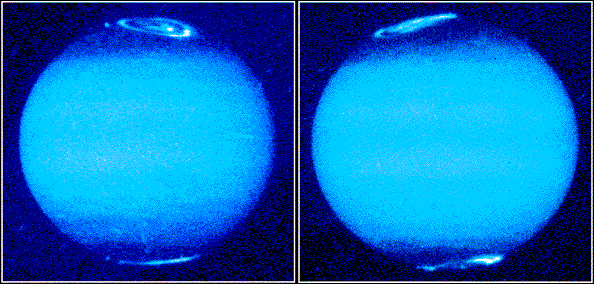
“Auroras are especially large on Jupiter. In pictures released yesterday, the Hubble Space Telescope imaged these unusual light displays in more detail than ever before. Jupiter's auroras are linked to its volcanic moon Io. Io's volcanoes release particles, some of which become ionized, trapped by Jupiter's magnetic field, and rain down on the gas giant. The resulting auroral displays may be thousands of times brighter than any auroral display on Earth, and involve unusual spots. The above pictures show how the extended auroral emissions rotate with Jupiter, while the auroral spots stay synchronized to Io as it circles Jupiter. "
Copyright: Public domain
#488 Lalande 21185: The Nearest Planetary System? October 19, 1996
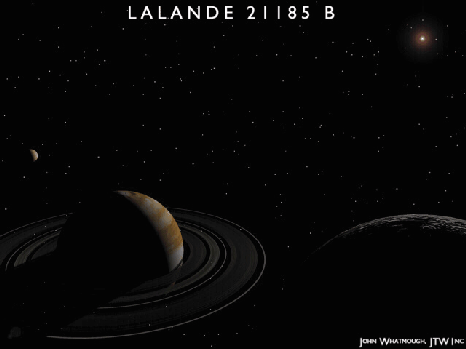
“What's the closest extrasolar planetary system? It may well be planets of the dim red dwarf star cataloged as Lalande 21185 -- a mere 8 light years distant. This star is too faint to be seen by the naked eye and its planets have not been imaged directly. Instead, their presence is inferred by a long series of telescopic observations, tracking the star as it wiggles and wobbles in mutual gravitational response to the masses of its orbiting planets. Our own planetary system would be detectable by such a technique ... Using data obtained from frequent observations of this star over the last 50 years, University of Pitsburgh astronomer George Gatewood recently announced that much of Lalande 21185's wobble is most likely due to an unseen planet with approximately 90% of the mass of Jupiter and an orbital period of 5.8 years. His work also indicates that a second and possibly third planet of similar mass could well be present in the system. Massive planets orbiting a red dwarf star would be very different from the Earth -- as illustrated in this artist's vision of a Jupiter-sized planet with rings and moons lit by a cool, dim sun. Nevertheless, the existence of a planetary system so near our own suggests the intriguing possibility that planets are common in our galaxy."
Copyright: Extrasolar Visions
#489 Surveyor Slides October 20, 1996
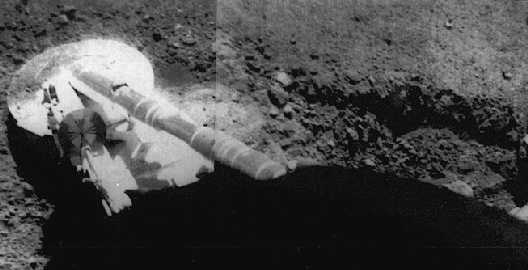
“"Safe!" -- In September 1967 (during regular season play), while making a successful soft landing on the Moon's Mare Tranquillitatis, the Surveyor 5 lander actually slid several feet. Equipped with television cameras and some soil sampling experiments, the US Surveyor spacecraft were intended to determined if the lunar surface at chosen locations was suitable for manned landings. Surveyor 5 touched down on the inside edge of a small crater inclined at about 20 degrees. Its footpad slipped and dug the trench visible in the picture. Covered with lunar soil, the footpad is about 20 inches in diameter."
Copyright: Public domain
#490 Orionids Meteor Shower to Peak Tonight
Credit: October 21, 1996
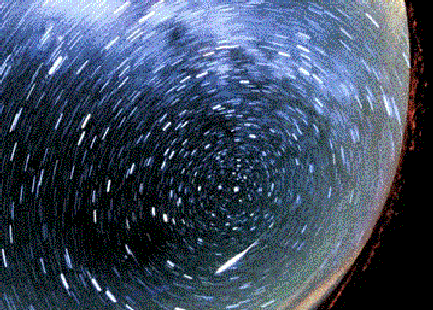
“Tonight you might be able to see Halley's Comet again - or at least some pieces of it. It is widely thought that that the meteors from the Orionids meteor shower, which peaks tonight, are just small pieces of Halley's Comet falling to Earth. During each pass near the Sun, a comet will heat up and shed pieces of ice and rock from its nucleus. This debris continues to orbit the Sun until either evaporating or being swept up by some large solar-system body. A piece of comet debris striking the Moon creates a small crater, but a piece striking the Earth usually burns up in the atmosphere causing a brief, bright streak. Every year at this time the Earth crosses an old stream of bits from Halley's Comet causing the Orionids display, named from the constellation (Orion) from which the meteors appear to originate. The streak below center in the above picture of the northern sky actually depicts a meteor from the Perseid meteor shower, a usually even more impressive display that peaks every year in mid-August."
Copyright: Public domain
#491 The Cracked Ice Plains of Europa October 22, 1996
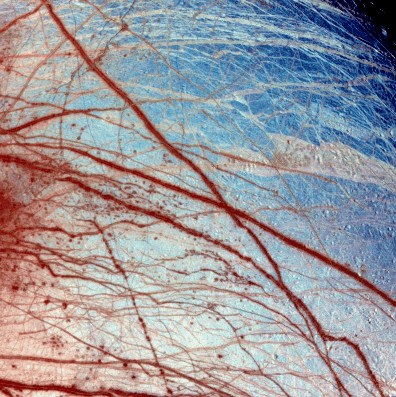
“What caused the cracks in this giant ice-ball? Jupiter's moon Europa has smoothest surface in the solar system and is composed mostly of cracked water-ice. In the above false-colored picture released last week by the NASA team in charge of the Galileo mission, blue hues represent ice plains divided by dirty red and brown bands of mottled terrain. As the robot Galileo spacecraft orbits Jupiter, it sends back revealing pictures of Jupiter and its large moons including Europa, Io, Ganymede, and Callisto. The region of Europa highlighted above is known as Minos Linea. The cause for many of the cracks remains unknown but may involve shifting stresses from gravity and temperature variations. The new Galileo pictures have increased evidence that liquid oceans may indeed exist under these giant ice-sheets, a place possibly ripe for the development of life. "
Copyright: Public domain
#492 The Large Cloud of Magellan (LMC)
Credit: October 23, 1996
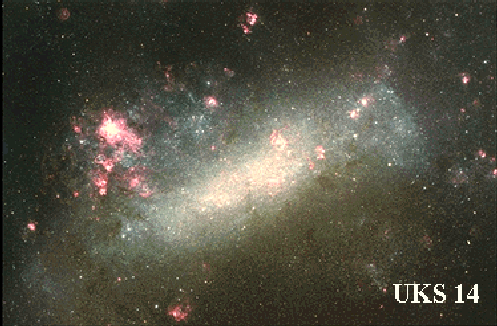
“Magellan and his crew had plenty of time to study the southern sky during their famous voyage around the world. As a result, two fuzzy cloud like objects in the southern sky are now known as the Clouds of Magellan. These star clouds are small irregular galaxies, satellites of our larger Milky Way spiral galaxy. The Large Magellanic Cloud (LMC) pictured above is only about 180,000 light-years distant - the only known galaxy closer is the Sagittarius Dwarf. Both the LMC and the Small Magellanic Clouds (SMC) are joined to the Milky Way by a stream of cold hydrogen gas whose origin is still controversial. An unusual effect called gravitational lensing has recently been detected in a few LMC stars, and there is hope this could tell us important information about the true composition of our universe. "
Copyright: Anglo-Australian Telescope Board
#493 Starbirth in the Lagoon Nebula
Credit and Copyright: October 24, 1996

“Stars are forming even today in the Lagoon Nebula. This bright nebula is visible in the constellation of Sagittarius with binoculars. The above photo is the result of a new sensitive camera being attached to one of the world's largest telescopes. Curtains of collapsing hydrogen are shown above in green, highlighted by a special filter that isolates light from this specific atom. Many young stars are evident in the open cluster M8 in the Lagoon, the result of previously collapsed gas clouds. Many of the stars appear red because of the high amount of dust in the Lagoon Nebula. Red light penetrates dust clouds best, although enough dust will block all visible light and leave a dark nebula. "
Copyright: Public domain
Upvote! Resteem! Comment! As you like it! Thank you for attention!